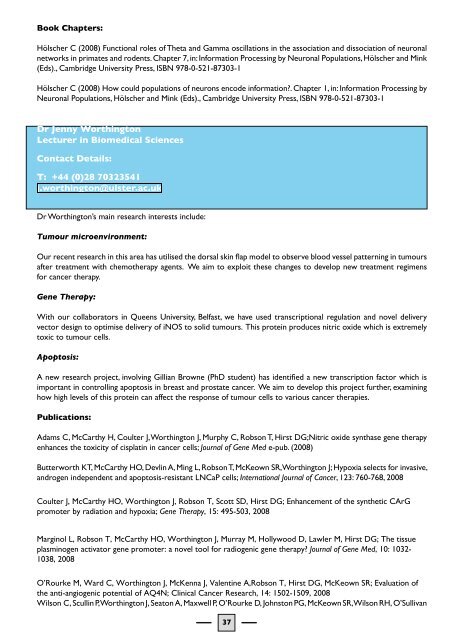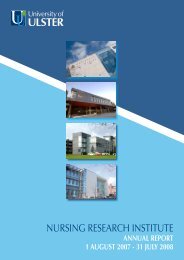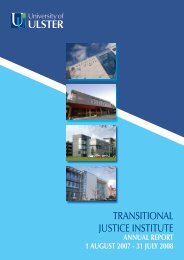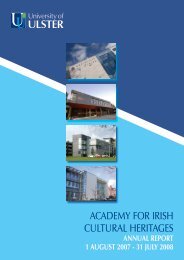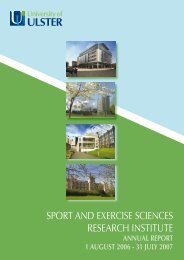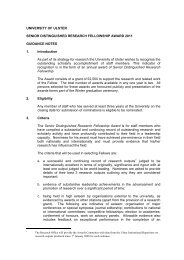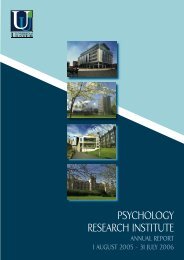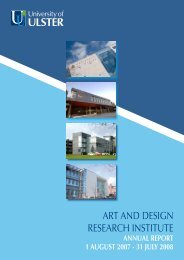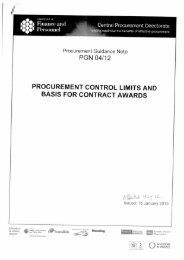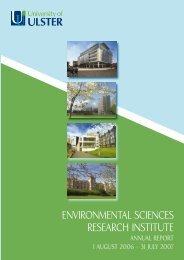an Alzheimer <strong>Research</strong> Trust collaboration grant (£30,000) to investigate “Insulin receptor activity in the brains <strong>of</strong> amouse model <strong>of</strong> Alzheimer’s Disease”. He has, more recently, obtained a significant project grant (£148,000) from theAlzheimer Society to conduct an “Analysis <strong>of</strong> novel GLP-1 agonists on neurodegenerative processes in a mouse model <strong>of</strong>Alzheimer’s Disease”.Deliverables:The <strong>research</strong> focuses on novel therapies for the treatment <strong>of</strong> Alzheimer’s Disease. Median term deliverables are theidentification and development <strong>of</strong> novel protease-resistant incretin analogues that can be applied safely and that activateneuroprotective and regenerative mechanisms in neurons. Ideally, novel treatments that prevent and protectfrom neurodegenerative processes will be developed, which would be <strong>of</strong> major benefit to the affected part <strong>of</strong> thepopulation.Dr Hölscher is a member <strong>of</strong> the Editorial Board <strong>of</strong> the journal ‘Artificial Intelligence’ and was recently appointed atthe Co-ordinator <strong>of</strong> the Alzheimer <strong>Research</strong> Trust Network in Northern Ireland (the <strong>of</strong>ficial launch <strong>of</strong> which tookplace in Belfast in February 2008).The Official Launch <strong>of</strong> theAlzheimer <strong>Research</strong> Trust Network <strong>of</strong> Northern Irelandat Belfast castle, 19 th February 2008From LtoR: Lady Sylvia Hermon MP, Dr Janet Johnston (QUB representative),Marie Janson (Head <strong>of</strong> the ART <strong>research</strong> section) and Dr Christian Hölscher (UU representative)Dr Hölscher was also invited to speak at the Annual Meeting <strong>of</strong> the Society for Neuroscience (San Diego, USA) inJuly 2008.Publications:Gengler S, Gault VA, Harriott P, Hölscher C; Beta-amyloid (25-35) induced impairments <strong>of</strong> hippocampal synaptic plasticityare dependent on stimulation-protocol, genetic background, and aggregation state; Experimental Brain <strong>Research</strong>,179: 621-630, 2007Holscher C, Gengler S, Gault VA, Harriott P, Mallot HA; Soluble beta-amyloid[25-35] reversibly impairs hippocampalsynaptic plasticity and spatial learning; European Journal <strong>of</strong> Pharmacology, 561: 85-90, 2007Gault VA and Hölscher C; A novel GIP agonist facilitates hippocampal LTP and reverses the impairment <strong>of</strong> LTP inducedby beta-amyloid; Journal <strong>of</strong> Neurophysiology, 99: 1590-1595, 2008Gault VA and Hölscher C; GLP-1 agonists facilitate hippocampal LTP and reverse the impairment <strong>of</strong> LTP induced bybeta-amyloid; European Journal <strong>of</strong> Pharmacology, 587: 112-117, 2008Invited Reviews:Li L and Hölscher C; Common pathological processes in Alzheimer Disease and Type 2 Diabetes: a review; Brain<strong>Research</strong> Reviews, 23: 58-65, 2007Hölscher C and Li L (2008): New roles for insulin-like hormones in neuronal signalling and protection: new hopes fornovel treatments <strong>of</strong> Alzheimer’s Disease? Neurobiol Ageing (in press).Book:‘Mechanisms <strong>of</strong> information processing in the Brain: Information Processing by Neuronal Populations’. C Holscherand M Munk (Eds.). Cambridge <strong>University</strong> Press, Cambridge UK. 2008, ISBN 978-0-521-87303-136
Book Chapters:Hölscher C (2008) Functional roles <strong>of</strong> Theta and Gamma oscillations in the association and dissociation <strong>of</strong> neuronalnetworks in primates and rodents. Chapter 7, in: Information Processing by Neuronal Populations, Hölscher and Mink(Eds)., Cambridge <strong>University</strong> Press, ISBN 978-0-521-87303-1Hölscher C (2008) How could populations <strong>of</strong> neurons encode information?. Chapter 1, in: Information Processing byNeuronal Populations, Hölscher and Mink (Eds)., Cambridge <strong>University</strong> Press, ISBN 978-0-521-87303-1Dr Jenny WorthingtonLecturer in Biomedical SciencesContact Details:T: +44 (0)28 70323541j.worthington@ulster.ac.ukDr Worthington’s main <strong>research</strong> interests include:Tumour microenvironment:Our recent <strong>research</strong> in this area has utilised the dorsal skin flap model to observe blood vessel patterning in tumoursafter treatment with chemotherapy agents. We aim to exploit these changes to develop new treatment regimensfor cancer therapy.Gene Therapy:With our collaborators in Queens <strong>University</strong>, Belfast, we have used transcriptional regulation and novel deliveryvector design to optimise delivery <strong>of</strong> iNOS to solid tumours. This protein produces nitric oxide which is extremelytoxic to tumour cells.Apoptosis:A new <strong>research</strong> project, involving Gillian Browne (PhD student) has identified a new transcription factor which isimportant in controlling apoptosis in breast and prostate cancer. We aim to develop this project further, examininghow high levels <strong>of</strong> this protein can affect the response <strong>of</strong> tumour cells to various cancer therapies.Publications:Adams C, McCarthy H, Coulter J, Worthington J, Murphy C, Robson T, Hirst DG;Nitric oxide synthase gene therapyenhances the toxicity <strong>of</strong> cisplatin in cancer cells; Journal <strong>of</strong> Gene Med e-pub. (2008)Butterworth KT, McCarthy HO, Devlin A, Ming L, Robson T, McKeown SR, Worthington J; Hypoxia selects for invasive,androgen independent and apoptosis-resistant LNCaP cells; International Journal <strong>of</strong> Cancer, 123: 760-768, 2008Coulter J, McCarthy HO, Worthington J, Robson T, Scott SD, Hirst DG; Enhancement <strong>of</strong> the synthetic CArGpromoter by radiation and hypoxia; Gene Therapy, 15: 495-503, 2008Marginol L, Robson T, McCarthy HO, Worthington J, Murray M, Hollywood D, Lawler M, Hirst DG; The tissueplasminogen activator gene promoter: a novel tool for radiogenic gene therapy? Journal <strong>of</strong> Gene Med, 10: 1032-1038, 2008O’Rourke M, Ward C, Worthington J, McKenna J, Valentine A,Robson T, Hirst DG, McKeown SR; Evaluation <strong>of</strong>the anti-angiogenic potential <strong>of</strong> AQ4N; Clinical Cancer <strong>Research</strong>, 14: 1502-1509, 2008Wilson C, Scullin P, Worthington J, Seaton A, Maxwell P, O’Rourke D, Johnston PG, McKeown SR, Wilson RH, O’Sullivan37
- Page 1: BIOMEDICAL SCIENCESRESEARCH INSTITU
- Page 4 and 5: 1 Foreword by the Pro Vice-Chancell
- Page 6 and 7: 2 Foreword by the Research Institut
- Page 8 and 9: The BMSRI Research StructureThe BMS
- Page 10 and 11: BMSRI Core FacilitiesContact: Karen
- Page 12 and 13: of Metabolomics, pharmacy, nutritio
- Page 14 and 15: BMSRI Academic Heads new Regional N
- Page 16 and 17: 4. BIOMEDICAL GENOMICS RESEARCH GRO
- Page 18 and 19: Recent Funding Initiatives:C-TRIC:
- Page 20 and 21: Dr Mateus Webba da SilvaLecturer in
- Page 22 and 23: 5. BIOIMAGING RESEARCH GROUPResearc
- Page 24 and 25: developmental alterations that mani
- Page 26 and 27: Publications:Bigot S, Lucas L, Morr
- Page 28 and 29: Publications:Barnes CA, O’Hagan B
- Page 30 and 31: We also measure the genotoxic effec
- Page 32 and 33: 6. CANCER AND AGEING RESEARCH GROUP
- Page 34 and 35: Professor Anthony P McHaleProfessor
- Page 36 and 37: Professor Stephanie McKeownProfesso
- Page 40 and 41: JM, Waugh DJJ; Dexamethasone potent
- Page 42 and 43: have wider applications in vivo, in
- Page 44 and 45: Inter-relationships between diet an
- Page 46 and 47: Flatt PR; Effective surgical treatm
- Page 48 and 49: These areas are the subject of seve
- Page 50 and 51: Dr YHA Abdel-WahabSenior Lecturer i
- Page 52 and 53: Dr VA GaultLecturer in Molecular Bi
- Page 54 and 55: McClean PL, Irwin N, Hunter K, Gaul
- Page 56 and 57: Publications:Duffy NA, Green BD, Ir
- Page 58 and 59: 8. MICROBIOLOGY AND BIOTECHNOLOGYRE
- Page 60 and 61: Publications:Graham RJL, Graham C,
- Page 62 and 63: analyses. However there is still a
- Page 64 and 65: Plessas S, Bekatorou A, Koutinas AA
- Page 66 and 67: Biochemical studies/ viral evasion
- Page 68 and 69: Dr Stephen McCleanLecturer in Prote
- Page 70 and 71: environmental remediation and as ro
- Page 72 and 73: 9. NORTHERN IRELAND CENTRE FOR FOOD
- Page 74 and 75: 26-28 Sept 2007: International Seaf
- Page 76 and 77: Dr Barnes has developed expertise i
- Page 78 and 79: Dr Alison GallagherSenior Lecturer
- Page 80 and 81: In addition, results of a pilot stu
- Page 82 and 83: Dr Maeve KerrResearch AssociateCont
- Page 84 and 85: Memberships of External Committees/
- Page 86 and 87: Indicators of Esteem:Professor McNu
- Page 88 and 89:
were examined. The intervention and
- Page 90 and 91:
Within this work both short-term an
- Page 92 and 93:
micronutrient supplementation at a
- Page 94 and 95:
10. STEM CELL & EPIGENETICS RESEARC
- Page 96 and 97:
Publications:Lees-Murdock DJ, Lau H
- Page 98 and 99:
Publications:Lees-Murdock DJ, Lau H
- Page 100 and 101:
11. SYSTEMS BIOLOGY RESEARCH GROUPT
- Page 102 and 103:
Kravtsov V, Swain M, Schuster A, Du
- Page 104 and 105:
Dr Daniel BerrarLecturer in Biomedi
- Page 106 and 107:
Zhang et al; Incorporating Feature
- Page 108 and 109:
Bala P, Baldridge K, Benfenati E, C
- Page 110 and 111:
In addition there is a growing them
- Page 112 and 113:
Clinical work involves development
- Page 114 and 115:
In 2009 he was appointed Chairman o
- Page 116 and 117:
Stevenson TR, Goodall EA and Moore
- Page 118 and 119:
Dr Raymond BeirneLecturer in Optome
- Page 120 and 121:
Dr Julie McClellandLecturer in Opto
- Page 122 and 123:
Graham JE, Moore JE, Moore JE, McCl
- Page 124 and 125:
Research Staff:Dr David OrrSenior R
- Page 126 and 127:
Dr Victoria McGilliganResearch Asso
- Page 128 and 129:
13. Externally Funded Projects duri
- Page 130 and 131:
Grant Holder Anderson, Prof RSFundi
- Page 132 and 133:
Funding Body Royal Irish AcademyAmo
- Page 134 and 135:
14. BIOMEDICAL SCIENCES RESEARCH IN
- Page 136 and 137:
Student: Simon GenglerTitle: Effect
- Page 138 and 139:
Student: Anisha MazumdarTitle: Anal
- Page 140 and 141:
Student: Clare RyanTitle: How does
- Page 142 and 143:
CONGRATULATIONS TO THE FOLLOWING PO


